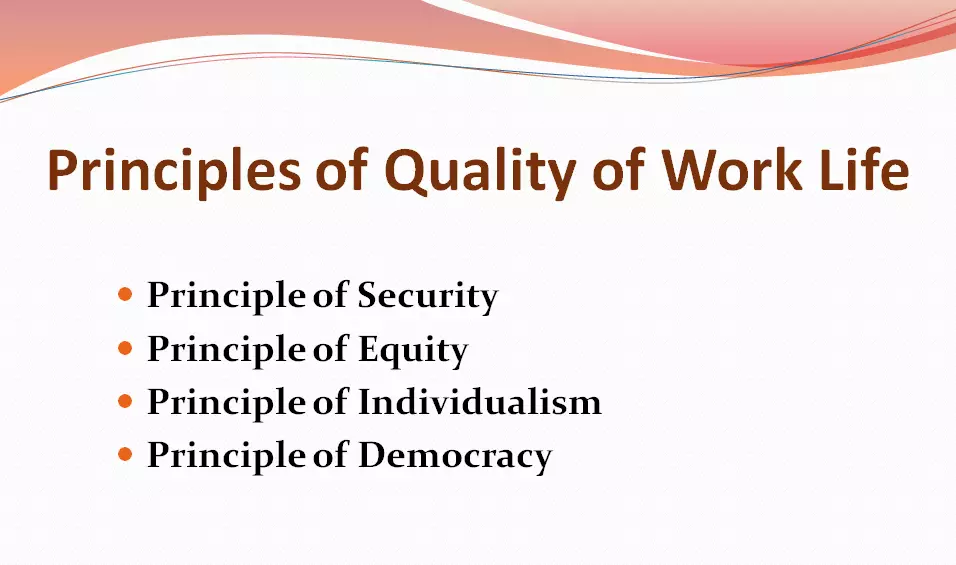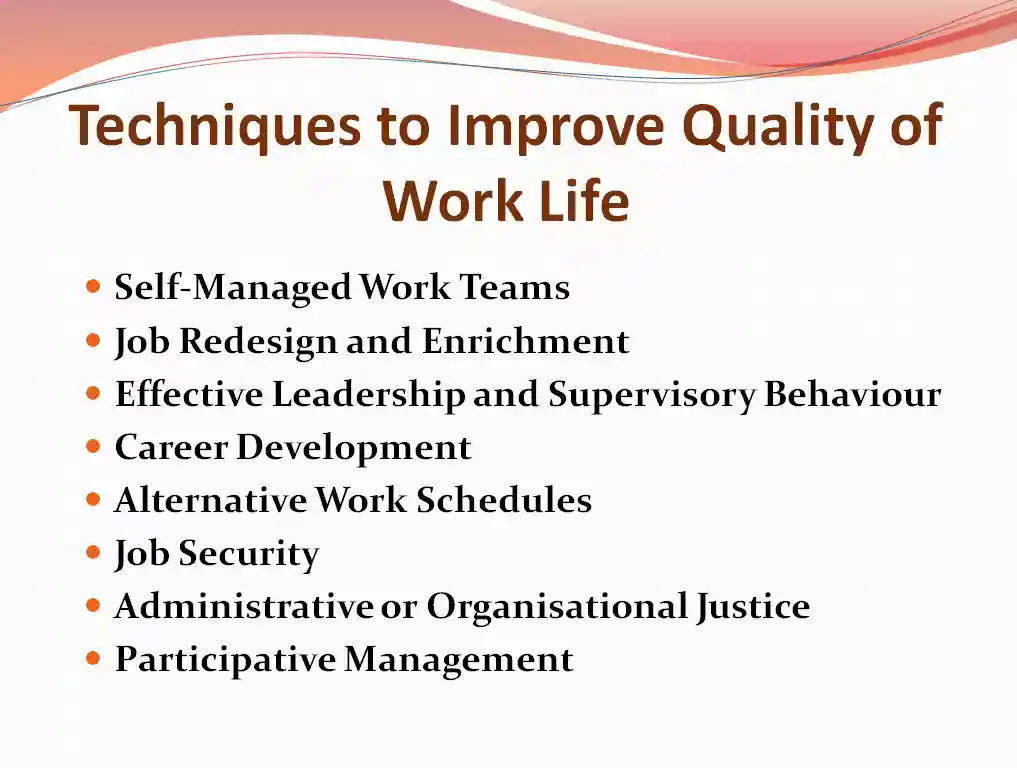Table of Contents:-
- Meaning of Quality of work life
- Definition of Quality of work life
- Objectives of Quality of work life
- Principles of Quality of work life
- Criteria for Measuring Quality of work life
- Techniques to Improve Quality of Work Life
Meaning of Quality of work life
Quality of work life in hrm deals with various aspects of the work environment that facilitate human resource development efficiently. Thus, quality of work life is one of the important functions of HRD. QWL motivates employees to learn for present and future roles.
QWL is one’s perceptions of the work experience. Since individual perceptions vary, the true meaning of quality of work life is unique to each individual. Industrial democracy, also known as co-determination, includes high-level employee participation in the decision making process. For others, mainly administrators and managers the term denotes improvements in the psychological aspects of work to improve productivity.
Unions and workers interpret it as a more equitable sharing of profits, job security, and healthy working conditions. Others view it as improving social relationships at the workplace through autonomous workgroups. Finally, others take a broader view of changing the entire organisational and HRD climate by humanising work, individualising organisations, and changing the structural and managerial systems.
However, in general, a high quality of work life exists when people have jobs that offer autonomy, variety and the feeling of making a meaningful contribution to the organisation’s effectiveness.
Definition of Quality of work life
According to Harrison, “QWL is the degree to which work in an organisation contributes to material and psychological well being of its members”.
According to D.S. Cohan, “QWL is a process of joint decision-making, collaborations and building mutual respect between management and employees”.
According to J. Richard and J. Loy, “QWL is the degree to which members of a work organisation are able to satisfy important personal needs through their experience in the organization”.
Objectives of Quality of Work Life
Objectives of Quality of Work Life aim at improving the well-being and job satisfaction of employees. The main objectives of Quality of Work Life QWL programmes are:
1) To improve employee satisfaction and create a positive attitude in the minds of employees;
2) To improve the physical and psychological health of employees, which creates positive feelings and reduces stress;
3) To enhance the productivity of employees and improve the standard of their living;
4) To reinforce workplace learning:
5) To improve management of the ongoing change and transition;
6) To build the image of the company as the best in recruitment, retention, and general motivation of talents,
7) To increase the effectiveness of the organisation (profitability, goal accomplishment, etc.), and
8) To help employees in the effective integration of their work and personal life.
Principles of Quality of work life
According to N.Q. Herrick and M. Maceoby, there are four basic principles, which will humanise work and improve the QWL, which are as follows:

1) Principle of Security
Quality of work cannot be improved until employees are relieved of the fear, anxiety, and loss of future employment. The working conditions must be secure and fear of economic want should be eliminated. Job security and protection against occupational hazards are essential preconditions for the humanization of work.
2) Principle of Equity
There should be a positive and direct relation between effort and reward. All types of discrimination among individuals engaged in similar work and with the same level of performance must be eliminated. Equity also demands the fair distribution of the organization’s profits.
3) Principle of Individualism
Employees differ in terms of their attitudes, skills, potential, etc. Therefore, every individual should be provided the opportunities for the development of his personality and potential. Humanisation of work requires that employees can decide their own pace of activities and design of work operations.
4) Principle of Democracy
This means greater authority and responsibility to employees. Meaningful participation in the group decision making process improves the quality of work life.
Criteria for Measuring Quality of work life
Walton proposed eight conceptual categories that collectively define the essence of work life quality. They are as follows:
1) Adequate and Fair Compensation
There are varying opinions regarding adequate compensation. The Committee on Fair Wages defined a fair wage as being ‘above the minimum wage but below the living wage’.
2) Safe and Healthy Working Conditions
Most organisations provide safe and healthy working conditions due to humanitarian requirements and/or legal requirements. These requirements are a subject of enlightened self-interest.
3) Opportunity to Use and Develop Human Capacities
Contrary to the traditional assumptions, QWL is improved to the extent that the worker can exercise more control of his or her work, and the extent to which the job embraces a complete meaningful task but not a part of it. Further, QWL provides opportunities like autonomy in work and participation in planning to use human capabilities.
4) Opportunity for Career Growth
Opportunities for promotions are limited for all categories of employees, either due to educational barriers or limited openings at the higher level. QWL provides future opportunities for continued development and security by expanding one’s knowledge, capabilities and qualifications.
5) Social Integration in the Workforce
One of the objectives of OWL is to generate a satisfying identity with the organisation and develop a feeling of self-esteem. The variables that include these are the absence of hierarchical status, opportunity for upward mobility, openness and trust, a sense of community feeling on the job and freedom from prejudice based on sex, caste, race and religion.
6) Constitutionalism in Work Organisation
QWL provides constitutional protections to the employees only to the level of desirability as it hampers workers. It happens because the management’s actions are challenged at every step, and bureaucratic procedures need to be followed at that level. Constitutional protection is provided to employees on matters such as free speech, privacy, equity and due process.
7) Work and QWL
QWL provides for a balanced relationship among various aspects of life, including family, work and non-work. In other words, family life and social life should not be strained by working hours including overtime work, business travel, work during inconvenient hours, vacations, transfers etc.
8) Social Relevance of Work
QWL is concerned about the establishment of social relevance in the workplace, ensuring that work is carried out in a manner that benefits society as a whole. The workers’ self-esteem would be high if their work is useful to society and vice versa holds as well.
Techniques to Improve Quality of Work Life
The techniques for improvement in quality of work life are as follows:

1) Self-Managed Work Teams
These are also called autonomous integrated work teams or work groups. These work teams are formed with the help of a team leader; these teams include 10 to 20 employees. The team leader is among those who plan, coordinate and control the team’s activities.
Each team is responsible for performing all activities, including the selection of their team members. Each team has the authority to make decisions and effectively regulate their respective activities. The group, as a whole, is accountable for its success or failure. Salaries are fixed both based on individual and group achievement.
2) Job Redesign and Enrichment
Narrow jobs can be combined into larger units of accomplishment, and jobs are redesigned to enrich them to satisfy higher human needs.
3) Effective Leadership and Supervisory Behaviour
For effective leadership and supervisory behaviour, the ‘9-9 style of managerial gird is suitable.
4) Career Development
Provision for career planning, communicating, career development and counselling the employees about career opportunities, career paths, education and second careers should be made.
5) Alternative Work Schedules
Provision for part-time employment, flexible working hours, job sharing and reduced work week should be made.
6) Job Security
Adequate security of the job is a high priority of employees and it should be taken care of.
7) Administrative or Organisational Justice
The principles of justice, fairness and equity should be taken care of in disciplinary procedure, grievance procedure, promotion, transfer, demotion, work assignment, leave etc.
8) Participative Management
Employees should be allowed to participate in management. Participative management may be of several types. The most sophisticated among them is a quality circle.
